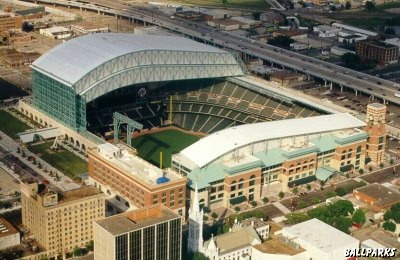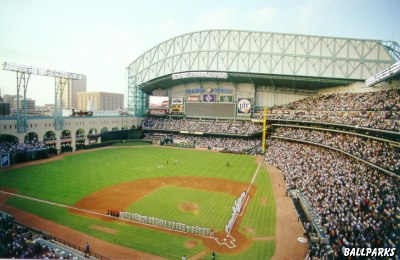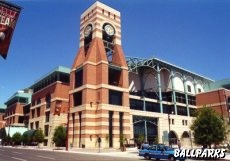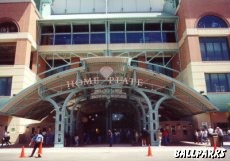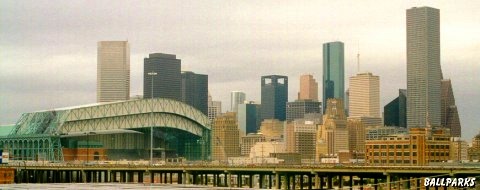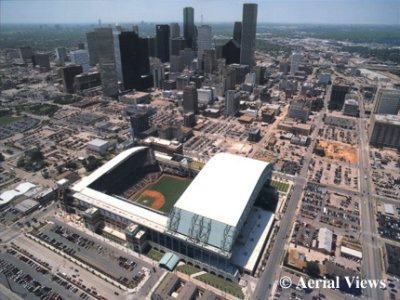Minute Maid Park
formerly Enron Field and Astros Field Houston, TexasTenant: Houston Astros (NL) Architect: HOK Sport (Kansas City) Houston Astros tickets:
Location: On the east side of downtown Houston at the corner of Crawford and Texas Streets, adjacent to Union Station and near the George R. Brown Convention Center. Left field (NW), Crawford Street; third base (SW), Texas Avenue; first base (SE), Hamilton Street; right field (NW), Congress Avenue. Dimensions: Left field: 315 ft.; left-center: 362 feet; center field: 435 feet; right-center: 373 feet; right field: 326 feet; backstop: 49 feet. Fences: Left field: 21 feet; center field: 9 feet; right field: 7 feet. Materials: Concrete and steel structure clad in brick and limestone. On May 20, 1996, a special sports task force recommended that Houston and Harris County spend $625 million to build a new baseball stadium and a new downtown basketball arena, and refit the Astrodome for football and the rodeo. It did not say how to pay for it, but it did recommend some possible revenue sources, including a sales tax and new taxes on cigarettes and mixed beverages. The report was given to Mayor Bob Lanier and Harris County Judge Robert Eckels, who appointed the 23-member Houston/Harris County Sports Facility Public Advisory Committee in January 1996. The Oilers moved to Tennessee in 1997 and the owners of the Astros and Rockets said they would consider moving to another city unless they got new venues. The franchises said they could not make enough money in their outdated facilities to compete against teams with new parks, stadiums and arenas. The draft report said it was difficult to measure the benefits of professional sports, but it estimated that such local businesses as restaurants and hotels earned an annual after-tax profit of $60 million on football, basketball and baseball. Astros owner Drayton McLane Jr. said a downtown stadium would be best for baseball because it would generate excitement and put the team closer to the center of the region's population. In 1995, he considered selling the Astros to Virginia businessman Bill Collins, who wanted to move the team to the suburbs south of Washington, D.C.
On November 5, 1996, the voters of Harris County approved the construction of a new ballpark in downtown Houston. Astros owner Drayton McLane Jr. had agreed that September to keep his team in Houston if the ballot measure passed. The $265 million ballpark has a retractable roof and a natural grass playing surface. It covers about 25 acres downtown in the area just northeast of the old Union Station. The streets which encompass the area are Texas, Congress, Crawford and US highway 59. Most of that land previously consisted of parking lots. McLane held a news conference on April 2, 1997 to discuss updates for the proposed ballpark. One new feature was an exploding scoreboard that was the biggest in baseball. It was reminiscent of the famous scoreboard that was removed from the Astrodome to expand the seating capacity in 1988. "The scoreboard will be all computer programmed," said Earl Santee, senior vice president with HOK Sports Facilities Group, which designed the stadium. "It’s a very wide scoreboard size-wise, and you can do a lot of different things with it. It’ll have the home-run signature of the old scoreboard at the Astrodome. There won’t be anything like it anywhere else. I know the fans really loved the old scoreboard, but I think they’re going to like the new one, too. We’re trying to build the best open-air ballpark possible, and we’re working as hard as we’ve ever worked on any project to make that happen." Having a retractible roof made the Houston project special for HOK, and Santee said he believed Minute Maid Park would be baseball’s best. Santee said the retractable roof, which cost $65 million, could open or close quietly in less than 20 minutes without interrupting the game. He estimated the roof would be open 60 percent of the time. The energy cost is about $5 per usage.
On April 7, 1999, Houston-based Enron Corporation agreed to pay more than $100 million over 30 years to name the stadium Enron Field. However, on December 2, 2001 Enron became the largest corporation in history to declare bankruptcy. On February 27, 2002, the Astros made an agreement with Enron to buy back the naming rights. After two full seasons of being called Enron Field, the home of the Houston Astros then became temporarily know as Astros Field. On June 5, 2002, the Astros announced that the Minute Maid Company, a locally-based subsidiary of the Coca-Cola Company since 1960, will pay an estimated $170 million for a 28-year naming rights deal. Minute Maid Park Trivia:
More on Minute Maid Park: Recommended Reading (bibliography):
Houston Astros Help us provide a better web site by completing our feedback form IMAGES: Aerial view of Minute Maid Park and downtown Houston © 2001 by Mike Smith. Updated August 2007 Web development assistance by Houston Computer Repair. Sponsorship and other considerations provided by Max Lang Belts and Buckles. Tickets to Houston Astros, Astros Cardinals, Astros Rangers, NCAA Basketball Tournament, College Football Bowl, NCAA Football, Houston Texans and Paul McCartney provided by Ticket Triangle. BALLPARKS © 1996-2014 by Munsey & Suppes.
|

